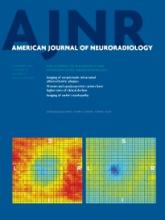Index by author
Mikulis, D.J.
- Research PerspectivesYou have accessHot Topics in Functional NeuroradiologyS.H. Faro, F.B. Mohamed, J.A. Helpern, J.H. Jensen, K.R. Thulborn, I.C. Atkinson, H.I. Sair and D.J. MikulisAmerican Journal of Neuroradiology December 2013, 34 (12) 2241-2249; DOI: https://doi.org/10.3174/ajnr.A3721
Mohamed, F.B.
- Research PerspectivesYou have accessHot Topics in Functional NeuroradiologyS.H. Faro, F.B. Mohamed, J.A. Helpern, J.H. Jensen, K.R. Thulborn, I.C. Atkinson, H.I. Sair and D.J. MikulisAmerican Journal of Neuroradiology December 2013, 34 (12) 2241-2249; DOI: https://doi.org/10.3174/ajnr.A3721
Moore, W.
- FELLOWS' JOURNAL CLUBPediatricsYou have accessDiffusion MRI Improves the Accuracy of Preoperative Diagnosis of Common Pediatric Cerebellar Tumors among Reviewers with Different Experience LevelsK. Koral, S. Zhang, L. Gargan, W. Moore, B. Garvey, M. Fiesta, M. Seymour, L. Yang, D. Scott and N. ChoudhuryAmerican Journal of Neuroradiology December 2013, 34 (12) 2360-2365; DOI: https://doi.org/10.3174/ajnr.A3596
DWI studies of 96 cerebellar pediatric tumors were analyzed by neuroradiologists and residents in radiology during 2 sessions, one that included the DWI studies and one that did not. These observers were asked to categorize the masses as: astrocytoma, medulloblastoma, ependymoma, or atypical teratoid/rhabdoid tumor. The addition of DWI resulted in significant improvement in the diagnosis of all tumors except ependymoma among all reviewers with different levels of experience.
Morris, J.M.
- FELLOWS' JOURNAL CLUBBrainYou have accessStroke-Like Migraine Attacks after Radiation Therapy (SMART) Syndrome Is Not Always Completely Reversible: A Case SeriesD.F. Black, J.M. Morris, E.P. Lindell, K.N. Krecke, G.A. Worrell, J.D. Bartleson and D.H. LachanceAmerican Journal of Neuroradiology December 2013, 34 (12) 2298-2303; DOI: https://doi.org/10.3174/ajnr.A3602
Clinical and imaging findings in 11 patients with SMART syndrome were reviewed. All patients became symptomatic on average 20 years postirradiation and all showed unilateral gyriform cerebral enhancement that resolved spontaneously in 2–5 weeks though 45% had residual neurologic deficits. Twenty-seven percent of patients developed laminar necrosis and brain biopsies of 4 patients showed nonspecific findings.
Mukherji, S.K.
- Head & NeckOpen AccessCT Perfusion Can Predict Overexpression of CXCL8 (Interleukin-8) in Head and Neck Squamous Cell CarcinomaS.Y. Jo, P.I. Wang, J.E. Nör, E.L. Bellile, Z. Zhang, F.P. Worden, A. Srinivasan and S.K. MukherjiAmerican Journal of Neuroradiology December 2013, 34 (12) 2338-2342; DOI: https://doi.org/10.3174/ajnr.A3610
Murad, M.H.
- FELLOWS' JOURNAL CLUBInterventionalYou have accessEndovascular Treatment of Distal Anterior Cerebral Artery Aneurysms: Single-Center Experience and a Systematic ReviewC.L. Sturiale, W. Brinjikji, M.H. Murad, H.J. Cloft, D.F. Kallmes and G. LanzinoAmerican Journal of Neuroradiology December 2013, 34 (12) 2317-2320; DOI: https://doi.org/10.3174/ajnr.A3629
Results from a single center treating 20 patients with distal anterior cerebral artery aneurysms were analyzed and compared with those reported in a meta-analysis of 16 studies in the literature that included a total of 279 similar patients. These aneurysms may be treated with a high rate of success but complication rates are higher than those for aneurysms of the circle of Willis.








